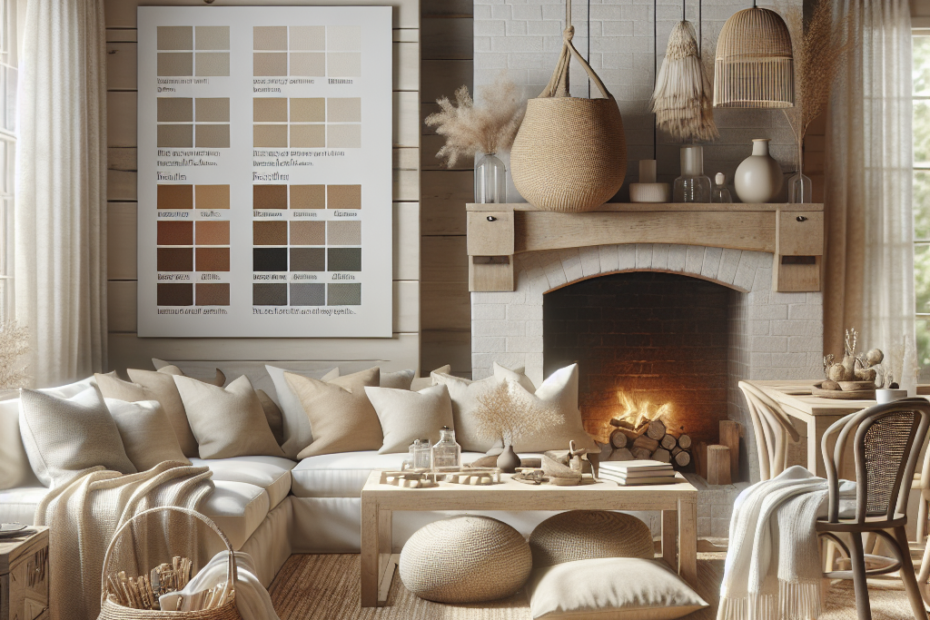“`html
Introduction:
In recent years, the farmhouse style has captivated homeowners, becoming a top pick for those seeking warmth and simplicity through design. A key element that has gained traction within this aesthetic is the use of warm neutrals in farmhouse design. People prefer this palette for its ability to evoke a sense of coziness and timelessness in any space. According to a Houzz survey, 50% of homeowners renovated their homes in a style that reflects farmhouse charm, and warm neutrals were often a dominant choice for those projects. This article delves into the essentials of incorporating such tones into modern farmhouse design.
Understanding Warm Neutrals:
They are colors that provide a gentle, inviting feel, typically including shades like beige, taupe, cream, and soft browns. Unlike bold palettes, these hues bring tranquility and a natural balance to interiors, making them a favorite for achieving a harmonious farmhouse look.
The Benefits of Warm Neutrals in Farmhouse Design:
- Versatility: Warm neutrals serve as a versatile backdrop, allowing diverse accent pieces to shine. Whether paired with rustic wood finishes or modern metallics, these tones complement a wide array of styles.
- Timelessness: Unlike trendy colors that come and go, warm neutrals have a timeless allure. Beige walls or taupe furniture can maintain their charm year after year, minimizing the need for frequent updates.
- Aesthetic Balance: These hues provide an excellent foundation for creating balance within any space. They can tone down bold elements, creating a peaceful, cohesive environment that aligns with the farmhouse ethos.
Incorporating Warm Neutrals in Farmhouse Design:
Integrating warm neutrals into a farmhouse setting can be both rewarding and straightforward. Here are some methods to enhance interiors using these hues:
| Feature | Tips for Incorporation |
|---|---|
| Walls | Choose soft beige or cream shades for walls to establish a subtle yet warm backdrop. |
| Furniture | Select pieces with natural wood finishes or upholstery in warm neutrals for a cohesive look. |
| Textiles | Incorporate throws and cushions in earthy tones, adding texture and warmth to spaces. |
| Decor | Opt for ceramics or vases in taupe or soft brown, adding understated elegance to rooms. |
Design Statistics:
- Approximately 30% of homeowners utilize neutral color schemes, with warm neutrals leading the pack due to their adaptability (RealSimple).
- Homebuyers are willing to pay 1-3% more for properties with well-executed neutral designs, indicating a favorable market perception (Zillow).
Key Takeaways:
- Warm neutrals are essential for creating inviting, balanced farmhouse interiors.
- They offer versatility and timelessness, fitting well with various design elements.
- When incorporating these colors, consider using them in walls, furniture, and decorative items for the best effect.
FAQ:
1. What are warm neutrals?
Warm neutrals are colors like beige, taupe, and cream that provide a cozy and timeless aesthetic to interiors.
2. Why are warm neutrals popular in farmhouse design?
They are popular due to their versatility, timeless appeal, and ability to complement other styles and elements within the home.
3. How can warm neutrals be used effectively in design?
They can be used in wall colors, furniture choices, textiles, and decorative items, creating a cohesive and inviting space.
4. Are warm neutrals suitable for modern farmhouse design?
Yes, they are suitable as they blend traditional farmhouse charm with a modern twist, making them highly adaptable.
5. What impact do warm neutrals have on property value?
A neutral palette can increase a property’s appeal to potential buyers, potentially boosting its market value.
“`
